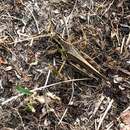Conservation Status
provided by University of Alberta Museums
During sporadic outbreaks and at high densities the northern grasshopper can cause damage to range lands and forage crops, but this species is also beneficial when it feeds on its preferred diet; lupine and loco (Pfadt 2002).
- license
- cc-by-nc
- copyright
- University of Alberta Museums
Cyclicity
provided by University of Alberta Museums
Melanoplus borealis nymphs (no wings or short wing buds) usually hatch in June depending on the elevation of the site, when the snow has melted and the soil has warmed. Adults (wings extend more than half the length of the abdomen) can be found about one month after the nymphs have hatched and tend to survive into mid-September (Pfadt 2002). For Alberta, there are records of adults in June through August (Strickland Museum).
- license
- cc-by-nc
- copyright
- University of Alberta Museums
Distribution
provided by University of Alberta Museums
This species is found across the northern part of North America. From coast to coast, it can be found in Alaska, sweeping down through the Canadian Shield and the northern half of the United States, across the Great Lakes and through the Maritime Provinces and Quebec (based on range map in Pfadt 2002). There are collection records for Alberta as far north as Peace River (Strickland Museum).
- license
- cc-by-nc
- copyright
- University of Alberta Museums
General Description
provided by University of Alberta Museums
The Melanoplus borealis is a dark medium-sized spurthroated grasshopper with red hind tibia. This and other grasshoppers of the subfamily Melanoplinae often have a spiny bump on their "throat" between their front legs (Johnson 2002). The wings of adult males usually extend to the apex of the hind femur, but in the females they are often shorter, covering only three quarters the length of the abdomen. The males of this species can be identified by the shape of their short and blunt cerci and theirsubgenitalplate which curves dorsally and terminates in a blunt truncate end. Females can be identified by using size, markers and colouring to associate them with the males (Pfadt 2002).
- license
- cc-by-nc
- copyright
- University of Alberta Museums
Habitat
provided by University of Alberta Museums
The northern grasshopper inhabits both lowland and mountainous areas, including arctic tundra, wet bogs, swamps and wet meadows (Pfadt 2002).
- license
- cc-by-nc
- copyright
- University of Alberta Museums
Life Cycle
provided by University of Alberta Museums
The life cycle of this species is described in Pfadt's Field Guide to Common Western Grasshoppers (2002). This species requires two years to break diapause before the nymphs hatch. Nymphs mature through 5 instars before emerging as an adult in July. About three weeks after emerging, the adults reach sexual maturity, and tend to mate during the warmest part of the day. Females begin oviposition 8 to 10 days after mating.
- license
- cc-by-nc
- copyright
- University of Alberta Museums
Trophic Strategy
provided by University of Alberta Museums
Besides its preferred diet of lupine and loco, this grasshopper eats dandelions, thistle, cinquefoil, red clover, other forbs and grasses and even dead insects (Pfadt 2002).
- license
- cc-by-nc
- copyright
- University of Alberta Museums
Melanoplus borealis
provided by wikipedia EN
Melanoplus borealis, known generally as the northern spur-throat grasshopper or northern grasshopper, is a species of spur-throated grasshopper in the family Acrididae.[1][2][3][4] It is found in North America.[1][5]
Subspecies
These four subspecies belong to the species Melanoplus borealis:
-
Melanoplus borealis borealis (Fieber, 1853) i
-
Melanoplus borealis palaceus Fulton, 1930 i
-
Melanoplus borealis stupefactus (Scudder, 1876) i
-
Melanoplus borealis utahensis Scudder, 1897 i
Data sources: i = ITIS,[1] c = Catalogue of Life,[2] g = GBIF,[3] b = Bugguide.net[4]
References

- license
- cc-by-sa-3.0
- copyright
- Wikipedia authors and editors
Melanoplus borealis: Brief Summary
provided by wikipedia EN
Melanoplus borealis, known generally as the northern spur-throat grasshopper or northern grasshopper, is a species of spur-throated grasshopper in the family Acrididae. It is found in North America.
- license
- cc-by-sa-3.0
- copyright
- Wikipedia authors and editors
Melanoplus borealis
(
Spanish; Castilian
)
provided by wikipedia ES
Melanoplus borealis[nota 1] es una especie de saltamontes perteneciente a la familia Acrididae.[1][2][3][4] Se encuentra en América del Norte.[1]
Subespecies
Cuatro subespecies pertenecen a la especie Melanoplus borealis:[1]
Notas
-
↑ En inglés es conocido como northern spur-throat grasshopper o northern grasshopper.
Referencias

- license
- cc-by-sa-3.0
- copyright
- Autores y editores de Wikipedia
Melanoplus borealis: Brief Summary
(
Spanish; Castilian
)
provided by wikipedia ES
Melanoplus borealis es una especie de saltamontes perteneciente a la familia Acrididae. Se encuentra en América del Norte.
- license
- cc-by-sa-3.0
- copyright
- Autores y editores de Wikipedia
Melanoplus borealis
(
Dutch; Flemish
)
provided by wikipedia NL
Insecten Melanoplus borealis is een rechtvleugelig insect uit de familie veldsprinkhanen (Acrididae). De wetenschappelijke naam van deze soort is voor het eerst geldig gepubliceerd in 1853 door Fieber.
Bronnen, noten en/of referenties Geplaatst op:
22-04-2013
Dit artikel is een beginnetje over biologie. U wordt uitgenodigd om op bewerken te klikken om uw kennis aan dit artikel toe te voegen.

- license
- cc-by-sa-3.0
- copyright
- Wikipedia-auteurs en -editors

